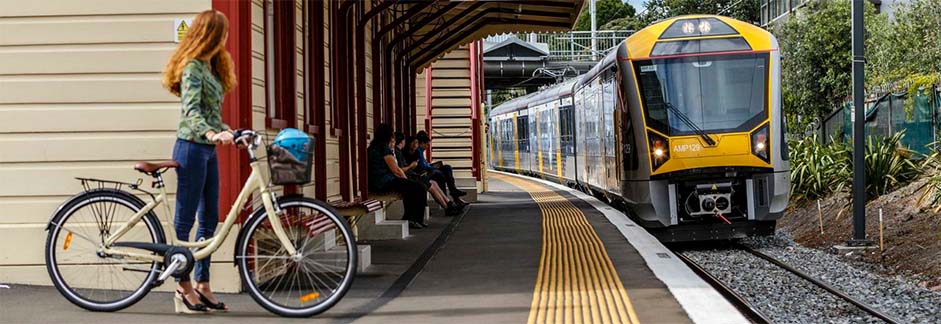Electric trains Electric trains
Auckland's electric trains make rail travel more attractive. The trains are faster, quieter and more energy-efficient, featuring the latest developments in technology and safety.
Project status: Completed
Project zone: Regional

Project purpose
- Electric trains build on significant investment by both regional and central government in redeveloping Auckland’s rail network.
- They replaced the second-hand diesel trains that came into service in the 1990s.
- They provided a major improvement in the level of customer service on the commuter rail network.
Benefits
- Faster, more frequent service.
- More people per train and units can be coupled to form six car trains.
- Environmentally friendly.
- Greater levels of customer comfort, information and safety
- Improved access - wider doors, automatic ramps for the mobility impaired and lower floors for push chairs or people with luggage.
- Safety improvements - cameras allow the driver to see all of the train and on-board CCTV camera system will operate continuously in all cars.
Timeline and target dates
2013 - Wiri depot opened. First electric train arrived.
2014 (April) - First train in service on Onehunga line. Manukau line gets electric trains.
2014 (Sept) - Eastern Line services began.
2015 (Jan) - Southern Line services progressively introduced. Full operations scheduled late July.
2015 (May) - Western line services being progressively introduced with full operations scheduled for late July.
2015 (May) - Weekend services on all routes.
2017 (Nov) - Contract signed with CAF for 15 more three-car trains.
2019 - First additional trains arrive.
2020 - (Jun) The first two of Auckland’s new trains are now up and running.
Project details
- Replacing Auckland’s diesel commuter rail fleet with new electric trains (EMUs).
- Trains purchased from Spain and designed to meet Auckland specifications.
- 57 three car trains which carry up to 232 seated passengers each.
- First train arrived in August 2013 and they all will be here by mid-2015.
- First train went into service in April 2014 on the Onehunga branch line.
- A new state of the art maintenance and stabling facility at Wiri is in full operation.
The new electric trains meet the latest international standards for bodyshell design to ensure the safety of passengers and crew is paramount.
Operating features
- The maximum operating speed is 110km/hr, however, the average operating speed will be less than this.
- Each train has regenerative braking, allowing energy to be produced by the train and fed back into the 25kv supply - a recovery of up to 20% of the energy used.
- Noise reduction: the 25kV power supply means that the trains are very quiet both externally and internally – a very important consideration for people living and working near the rail network.
- Sliding plug-type doors provide a good weather and sound proof seal.
- No air pollution because the trains are electric and there are no exhaust fumes.
- The electric trains have a special coupling to allow them to link with diesel locomotives for easy haulage in event of a major power outage.
Passenger features
- Each train seats 232 passengers and there is standing room for more.
- Fresh, modern décor and non-slip flooring.
- Wider doors than the current trains making passenger flow on and off the trains easier and faster, and easier for people with disabilities.
- The central carriages are at platform level, with automatic ramps, providing a seamless transition between the platform and the train for wheelchairs, mobility devices, bikes and prams.
- Space under seats for luggage, folding bikes, guide dogs etc.
- All doors have obstacle detection systems so they automatically open and re-close if something is trapped in the door.
- State-of-the-art air-conditioning to ensure the train is comfortable through the range of Auckland weather conditions.
- International best practice passenger information systems ensure that both audio and visual information is easy to understand; contrasting within the interior is designed to assist the visually impaired.
Security features
- An onboard CCTV camera system operates continuously in all cars, providing images to the driver from any of the 16 cameras within a train (images continuously recorded onboard and are available for investigation following any incident).
- Emergency call points throughout the train allow passengers to communicate directly with the train crew in the event of an incident.
Technical specifications
- 155 tonnes (weight of 3 cars, fully loaded).
- Overall length: 72m (3 cars).
- Power supply: 25kV AC overhead supply.
- 12 doors (4 per car) with 1.45m open width.
- Maximum acceleration rate: 1m/s/s.
- Maximum braking rate: 1m/s/s.
Key facts
- 57 three-car trains.
- Stainless steel outer shell.
- 155 tonnes (approximate weight of 3 cars, fully loaded).
- Overall length 72m (3 cars, each car is approximately 24m long).
- 25kV AC overhead power supply.
- Maximum speed is 110km/hr.
- Regenerative braking - recovers up to 20% of the energy used.
- Noise reduction - trains are quiet both externally and internally.
- Reduced carbon footprint - no diesel and no air pollution from the trains.
Download a printable copy of the specifications (PDF 4.69MB)
See a history of transport in Auckland (PDF 2.41MB)
Electrification
With the introduction of new electric trains, KiwiRail electrified Auckland’s suburban rail network.
Electrification extends from Papakura in the south to Swanson in the west, and includes the Onehunga Branch Line and Manukau Rail Link.
Trains are powered from a wire held overhead by masts and cantilevers. The 25kv AC power system (currently used on the North Island Main Trunk between Hamilton and Palmerston North), is used widely overseas and was assessed as the most suitable option for Auckland.
There are 72 electric trains operating now.